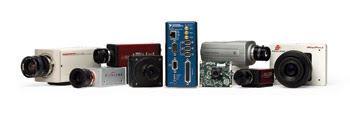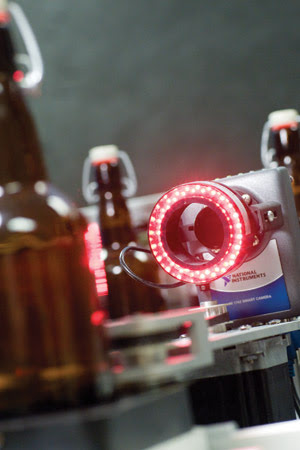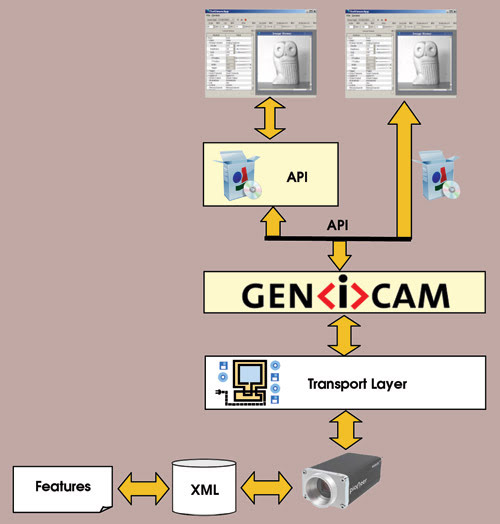Forthcoming revisions to Camera Link and GenICam might aid camera makers and users alike.
Hank Hogan, Contributing Editor
Upcoming changes in the communications standards that drive machine vision could mean cheaper and more capable setups as well as a greater ability to mix and match hardware and software. Developments throughout the next year in the Camera Link and GenICam standards also could make things easier and less costly for manufacturers and end users alike. A look at these changes reveals what their impact might be.
Generalizing GenICam
With regard to GenICam, plans call for the standardized and unified programming interface for cameras to extend its reach in several directions. One such extension is to have the standard cover not just the camera but also the transport layer — or the driver and interface — that connects the camera to the controlling software. Another extension involves the syntax in the camera description, which is typically stored in an xml file within the camera itself. A third involves a protocol driver for Camera Link, which would enable devices using that system to be treated in the software as a GigE Vision or IEEE-1394 camera.

“To me, the most important issue is the transport layer DLL [dynamic link library] because it will allow customers not only to interchange cameras but also drivers,” said the chairman of the GenICam standards group, Friedrich Dierks of Basler AG in Ahrensburg, Germany.
Dubbed the GenTL module, the transport layer extension will be accomplished through a DLL. The module will give access to the registers of a camera and enable the acquisition of images. This will be handled via a thin adapter layer that maps the GenICam elements to the appropriate camera commands and components.
This approach will transform what have been closed systems into ones where cameras and interfaces can be mixed and matched as needed. The change could result in a number of benefits, including faster product innovation and lower cost for manufacturers, as well as greater choice and flexibility in imaging solutions for users.
Work on the GenTL module has been under way for some time and, according to Dierks, an initial draft of the document is done, along with a working prototype of a reference implementation. Several companies are using the draft to create software adapters for their drivers and library products. Interoperability will be tested for a proof of concept prior to releasing the standard, which is expected to occur in the second quarter of 2008.
As for the other changes, extending the syntax of the xml file must be done with care to ensure backward compatibility. This change also is expected to be ready in the second quarter of 2008.
Bringing Camera Link devices under the GenICam umbrella is more technically challenging because of the various ways to access the former’s camera parameters. Dealing with this variety requires cooperation from suppliers. “Every camera company needs to provide a protocol driver which maps the company’s protocol to a register-based interface in GenICam style,” Dierks said
There are ways to get this done. The simplest would be a DLL-based solution. However, this would mean jettisoning the platform independence that GenICam currently enjoys unless vendors provide a DLL for all operating systems. A more general approach would be to put an interpretive computer language in GenICam itself, but that has its own drawbacks in terms of complexity.
The committee has yet to decide how to proceed, Dierks noted. However, he expects a solution to be arrived at and available by midyear.
A mixed picture
Vendors give mixed reviews and predict a mixed impact for efforts to extend the standard.
According to Mats Lindeberg at Pleora Technologies Inc. in Kanata, Ontario, Canada, GenICam with the GenTL module will make open standards such as GigE Vision and GenICam appealing to many users but will not replace existing software development kits.
He noted that Pleora, a supplier of GigE-based connectivity equipment for high-performance machine vision applications, is developing an image acquisition library with the GenTL interface but is continuing to develop a proprietary software development kit as well. Explaining why the company was taking a two-way approach, Lindeberg said that using GenTL for custom application development necessitates in-depth technical knowledge, whereas the company’s own software provides a more user-friendly experience. Thus, users may opt for the non-GenTL solution.
Others see the situation differently. Rupert Stelz, a software developer for Stemmer Imaging GmbH of Puchheim, Germany, noted that, with the GenTL module, users could have the same software interface for GigE Vision, IEEE-1394 and even USB cameras. For end users and OEMs, this universality brings benefits when new applications are developed. “The implementation process gets much quicker and cheaper,” he said.
He added that there might be cases where a specialized software development kit offers capabilities and performance that the generic GenTL does not. However, if GenTL achieves its goal and offers a solution that meets the needs of 95 percent of customers, he said that is likely to be enough to make the generic approach very attractive for most of the market.
Changes in Camera Link
Camera Link and GigE Vision, which are owned by the Automated Imaging Association (AIA), also are heading toward change, although not equally. According to Jeff Fryman, the association’s director of standards development, a cosmetic revision to GigE Vision is due midyear; however, Camera Link is another story.
Work is under way on extending the Power over Camera Link (PoCL) standard to all configurations of Camera Link. Other developmental efforts include what has been dubbed Camera Link Lite, which will have a substantially smaller connector, albeit with more limited capabilities, than the full version. The latter, Fryman noted, is most appealing in situations where the current connector is a significant size compared with that of the camera. The new connector will be no more than one-quarter the size of the current one.
Fryman sees a revision in cable specifications as having a potentially significant effect. Currently, Camera Link cables are specified via a physical standard and, therefore, meet requirements related to their construction. The revision will change the standard so that the cables must meet an electrical performance specification. As a result, new types might be certifiable as meeting the standard, which could provide some benefits.
“Maybe they will be less expensive, maybe they will be more flexible or maybe they will have a better performance,” Fryman said. He predicted that this and other revisions being contemplated would be completed by the end of 2008.
According to Gunnar Jonson of JAI A/S in Glostrup, Denmark, the addition of an electrical specification for cables would help improve the overall performance of the Camera Link systems. Another benefit could be more consistent performance from manufacturer to manufacturer. On the other hand, he said that any cost reduction would be a secondary benefit, likely arising from a wider acceptance of Camera Link.
There might be one exception to that statement. Jonson also noted that most Camera Link installations use cables that are shorter than 5 m, half of the maximum 10 m of the specification. Switching to electrical instead of physical requirements could benefit those installations. “There is a chance for manufacturers to make cheaper cables for the cases where the length does not need to be the full 10 m,” he said.

Most Camera Link installations use cables <5 m long, but switching to electrical instead of physical requirements in the standard could benefit such applications.
Anita Salmon, a senior hardware engineer at National Instruments Corp. of Austin, Texas, noted that cheaper Camera Link cables might be one outcome of the cable specification revision. However, she did not think that the difference would be noticed by end users. The problem, she said, is the data rates called for by Camera Link. The upper end of the specification currently supports transfer rates of 680 MB/s, and hitting that speed cannot be done with a cheap cable.
“To achieve the signaling rates that are involved in Camera Link, you have to have a pretty well designed cable, particularly if you want to be at the upper end of the frequency range,” Salmon said.
It might be possible to reduce the cost or to change the cable length by changing the design of cables targeted at the lower end of the specification. In that case, she pointed out, there already are alternatives in IEEE-1394 and Gigabit Ethernet for those situations where cost and cable length are driving factors.

By mid 2008, the GenICam standard could expand to include the transport layer, which links the camera to the software and should increase the end users' ability to mix components for their applications. Courtesy of Friedrich Dierks of Basler AG and of the GenICam standard group.
The question of what effect the changes to Camera Link and GenICam will have probably will not be settled until after the revisions are completed and have been in use for a while. By then, of course, it is likely that the standards will begin changing again. For example, there already is talk — and some preliminary work — on a standard that will offer higher data transfer rates than Camera Link currently provides.